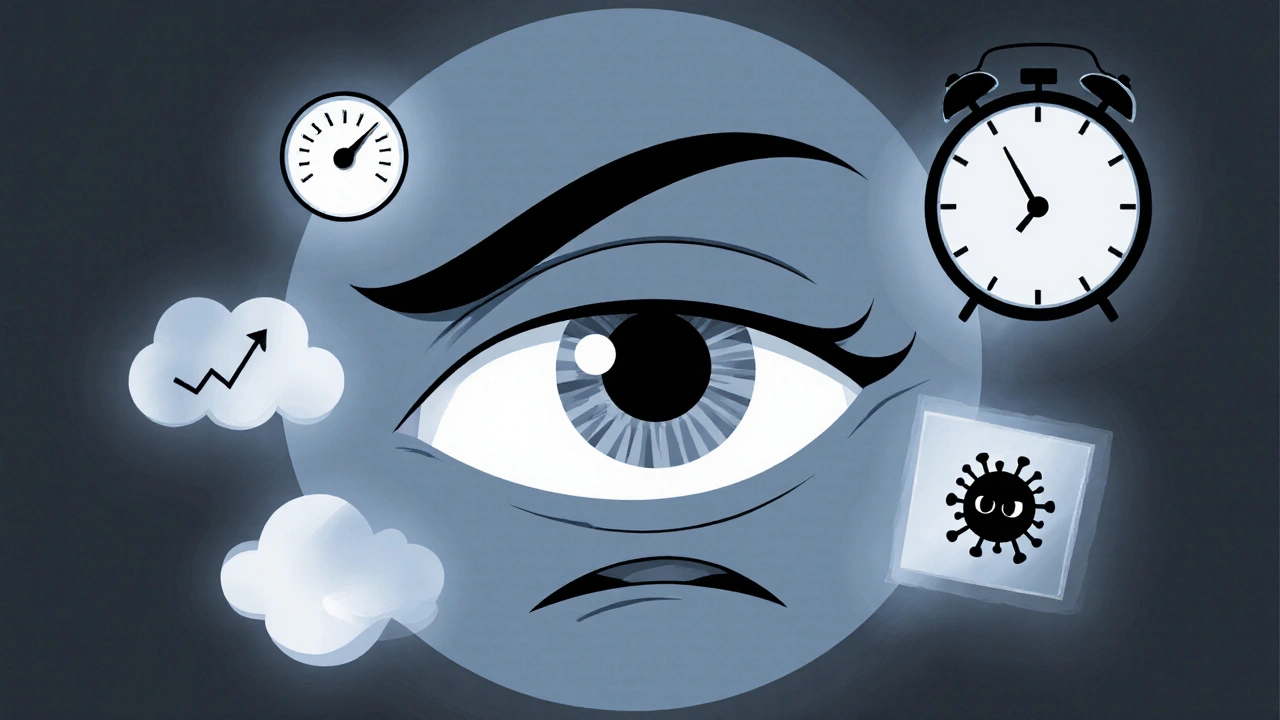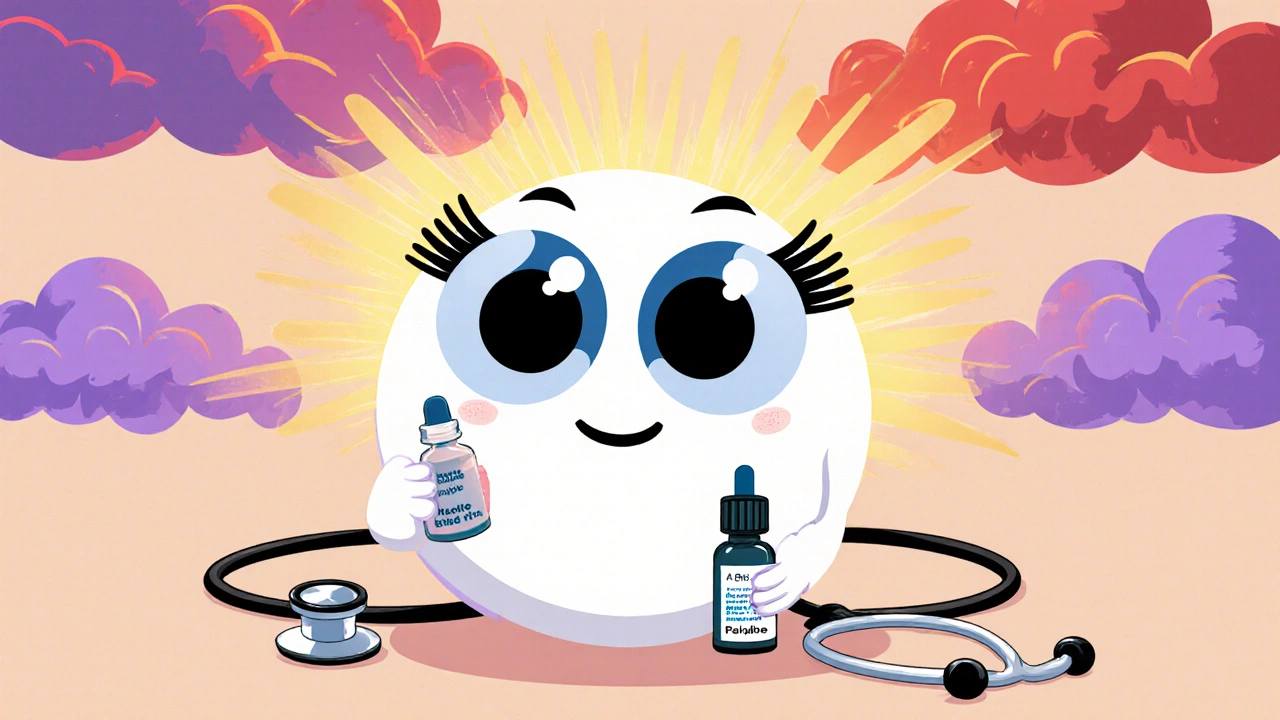Using steroid eye drops can feel like a quick fix for red, itchy, or painful eyes. If you’ve been prescribed prednisolone, dexamethasone, or loteprednol, you’re not alone. These drops are powerful tools for calming down serious eye inflammation - but they come with hidden dangers if used the wrong way. Many people don’t realize that even a few weeks of use can start causing damage you can’t see until it’s too late.
What Steroid Eye Drops Actually Do
Steroid eye drops - also called corticosteroid ophthalmic solutions - work by shutting down the body’s inflammatory response. When your eye is swollen from uveitis, allergic conjunctivitis, or trauma from a chemical burn, these drops stop the immune system from overreacting. That’s why they work so fast. Someone with severe anterior uveitis might notice their vision clearing up in just a day or two.
Drugs like Pred Forte (prednisolone acetate) and Omnipred are common. They’re not antibiotics, so they won’t treat infections. But they’re incredibly effective at reducing swelling, redness, and pain caused by non-infectious conditions. That’s why ophthalmologists reach for them when inflammation threatens vision.
But here’s the catch: the same mechanism that helps your eye heal can also hurt it. Steroids suppress local immunity. That means bacteria, viruses like herpes simplex, or even fungi can take over if you’re using these drops too long. One study found that immune suppression starts within days of starting treatment. That’s why doctors warn against using them for more than a couple of weeks unless closely monitored.
The Big Risks You Can’t Ignore
The biggest danger with steroid eye drops isn’t a side effect you feel right away. It’s what happens slowly - over weeks or months - without symptoms.
Steroid-induced glaucoma is the most serious risk. These drops can raise pressure inside your eye (intraocular pressure, or IOP). For most people, that pressure goes back to normal once they stop the drops. But for about 4-6% of users - called “steroid responders” - the pressure stays high and damages the optic nerve. That damage is permanent. And here’s the scary part: you won’t feel it. No pain. No redness. Just gradual loss of side vision, then tunnel vision, and eventually blindness.
Studies show that 30-40% of people experience some rise in eye pressure with steroid use. But only a small percentage develop full-blown glaucoma. The risk goes up if you already have glaucoma, diabetes, or a family history of the disease. Even young, healthy people can be responders. There’s no way to predict who will be affected until it happens.
The second major risk is cataracts. Long-term use - especially beyond 10 days - increases the chance of developing posterior subcapsular cataracts. These form at the back of the lens, right in the center of your vision. Unlike age-related cataracts, which develop slowly over years, steroid-induced ones can appear in months. If you’re on these drops for more than three months, your risk jumps significantly. And if you need surgery later, it’s not risk-free. About 20% of people develop clouding behind the new lens within five years.
And yes - you can get infections. Herpes simplex keratitis can flare up or worsen. Fungal infections, though rare, are harder to treat and can destroy the cornea. Steroids make your eye defenseless.
How Long Is Safe to Use Them?
There’s no universal answer, but there are clear guidelines.
For mild conditions like seasonal allergies or minor irritation, a short course of 3-7 days is usually enough. Low-dose drops used for under two weeks carry minimal risk. But if you’re treating uveitis or post-surgery inflammation, your doctor might prescribe them for up to four weeks. Beyond that, the risk of complications rises sharply.
High-potency drops like prednisolone acetate are especially dangerous if used longer than four weeks. Even moderate doses used for more than two months can trigger cataracts or glaucoma in susceptible people.
Some patients need longer treatment - maybe for autoimmune uveitis or chronic inflammation. In those cases, the goal isn’t to stay on steroids forever. It’s to use the lowest possible dose for the shortest time. Doctors often switch to non-steroidal anti-inflammatory eye drops (like ketorolac) once the acute inflammation is under control. They don’t work as fast, but they don’t raise eye pressure or cause cataracts.

Monitoring: What Your Eye Doctor Will Check
If you’re on steroid eye drops for more than 10 days, regular check-ups aren’t optional - they’re life-saving.
Your doctor will start with a baseline eye exam before you begin treatment. That includes measuring your eye pressure with Goldmann applanation tonometry - the gold standard. They’ll also check your cornea, lens, and optic nerve with a slit-lamp.
During treatment, you’ll need follow-ups every 2-4 weeks. If you’re a high-risk patient - say, you have diabetes or a family history of glaucoma - you might need to come in every week. At each visit, your pressure will be checked. If it rises above 21 mmHg, your doctor may add a pressure-lowering drop or reduce your steroid dose.
After three months of use, they’ll likely schedule a visual field test to check for peripheral vision loss - the first sign of optic nerve damage. They’ll also look for early cataract changes using specialized lighting.
Don’t skip these appointments. Many people feel fine and assume the drops are working perfectly. But damage can be happening silently. By the time you notice blurry vision or halos around lights, it might already be too late.
What Symptoms Mean You Need to Call Your Doctor Now
Some signs can’t wait. If you notice any of these, contact your eye doctor immediately:
- Blurry vision that doesn’t improve
- Eye pain or aching around the eye
- Redness that gets worse instead of better
- Seeing halos or glare at night
- Loss of side vision (like looking through a tunnel)
- Nausea or vomiting with eye pain
These could signal rapidly rising eye pressure or a serious infection. Don’t wait until your next appointment. Delaying care could mean permanent vision loss.
Stopping Steroid Eye Drops: Don’t Quit Cold Turkey
It’s tempting to stop the drops as soon as your eye feels better. But that’s a mistake. Steroid eye drops can cause rebound inflammation - your eye gets worse than before because your body has become dependent on the drug to suppress the immune response.
Your doctor will slowly taper your dose. For example, they might go from four times a day to twice a day, then once a day, then every other day. This gives your eye time to resume normal function without triggering a flare-up.
Never stop or change your dose without talking to your doctor first. Even if you feel fine, the inflammation might still be lurking under the surface.
Alternatives When Steroids Are Too Risky
If you’re at high risk for glaucoma or cataracts, or if you’ve had complications before, there are alternatives.
Non-steroidal anti-inflammatory drugs (NSAIDs) like ketorolac or bromfenac can help with mild to moderate inflammation. They don’t work as fast as steroids, but they’re much safer for long-term use. They’re often used after eye surgery to reduce swelling without raising pressure.
Immunosuppressants like cyclosporine or tacrolimus eye drops are another option for chronic conditions like dry eye or autoimmune uveitis. They take weeks to work, but they don’t cause cataracts or glaucoma.
For severe cases, systemic treatments - like oral medications or injections - might be needed. These require coordination with a rheumatologist or immunologist, but they can reduce the need for eye drops altogether.
Final Thoughts: Use Them Wisely
Steroid eye drops are powerful. They can save your vision - or ruin it. The difference comes down to how you use them.
If you’re prescribed these drops, ask your doctor: How long should I use them? What are my risk factors? When do I need to come back? Keep a log of your usage and any symptoms. Don’t assume you’re fine just because your eye doesn’t hurt.
Most people use steroid eye drops safely when they follow their doctor’s instructions. But for those who don’t monitor closely, the consequences can be devastating. Vision loss from steroid-induced glaucoma or cataracts is often irreversible. The best defense? Awareness, regular check-ups, and never letting convenience override caution.
Can steroid eye drops cause permanent blindness?
Yes, if used improperly or without monitoring. Steroid-induced glaucoma can damage the optic nerve permanently, leading to irreversible vision loss. Cataracts caused by long-term use can also severely impair vision. Both conditions progress without pain or obvious symptoms until significant damage has occurred. Early detection through regular eye pressure checks and exams is the only way to prevent this.
How often should eye pressure be checked when using steroid drops?
For most people using steroid eye drops for more than 10 days, eye pressure should be checked every 2-4 weeks. If you’re at higher risk - due to diabetes, glaucoma, or family history - your doctor may want to check it every 1-2 weeks. Potent steroids like prednisolone acetate require more frequent monitoring. Baseline pressure should be measured before starting treatment, and follow-ups should continue even after you stop using the drops.
Are there steroid eye drops with fewer side effects?
Yes. Loteprednol etabonate (e.g., Alrex, Lotemax) is designed to break down quickly in the eye, reducing the chance of pressure spikes and cataract formation. It’s often preferred for longer-term use because it has a better safety profile than older steroids like prednisolone. But no steroid is completely risk-free. Even low-risk drops still require monitoring if used beyond two weeks.
Can I use steroid eye drops for dry eyes?
Sometimes, but only under strict supervision. Steroids can reduce inflammation in severe dry eye disease, especially if it’s linked to autoimmune conditions like Sjögren’s syndrome. However, they’re not first-line treatment. Artificial tears, cyclosporine drops (Restasis), or lifitegrast (Xiidra) are safer for long-term dry eye management. Steroids are reserved for short-term flare-ups and always with regular pressure checks.
What happens if I miss a dose of steroid eye drops?
If you miss one dose, don’t double up. Just skip it and go back to your regular schedule. Missing doses occasionally won’t cause major issues, but inconsistent use can lead to rebound inflammation. If you’re missing doses often, talk to your doctor. They may switch you to a longer-acting formulation or adjust your treatment plan. Never stop the drops abruptly - always follow your doctor’s tapering instructions.
Do steroid eye drops affect blood sugar or other body systems?
Yes, even though they’re applied to the eye, small amounts can be absorbed into the bloodstream. In rare cases, especially with prolonged use or high doses, they can raise blood sugar levels, cause mood changes, or increase blood pressure. People with diabetes need to monitor their glucose more closely. These systemic effects are uncommon with short-term use but become more likely beyond 3-4 weeks.


Aidan McCord-Amasis
Just took my last drop yesterday. Still alive. 😅
Katie Baker
I was so scared when my doc prescribed these for my uveitis flare-up, but I followed every check-up and now my vision’s clearer than ever. Seriously, listening to your doctor saves your sight. 💙
Edward Ward
It’s fascinating how something so seemingly benign-eye drops-can silently rewire your body’s defenses. The fact that intraocular pressure can climb without a single symptom is a chilling reminder of how much our bodies hide from us. I’ve seen friends lose peripheral vision and not realize it until their next annual exam. That’s not negligence-it’s biological invisibility. And yet, we treat these drops like Advil. We pop them, we forget them, we assume they’re harmless because they’re topical. But the eye isn’t just a surface; it’s a window into systemic vulnerability. And if you’re diabetic, or have a family history of glaucoma, or even just over 40-you’re not just a patient. You’re a statistical outlier waiting to happen. The real tragedy isn’t the drug. It’s the assumption that if you don’t feel pain, you’re safe.
Hollis Hollywood
I’ve been on loteprednol for six months now for chronic dry eye linked to Sjögren’s. I know I shouldn’t be, but my eyes feel so much better than with Restasis alone. I go in every three weeks for pressure checks-my doc even gave me a little log sheet. I track every drop, every blurry day, every weird halo at night. I’m not gonna lie-it’s exhausting. But I’d rather be tired from monitoring than blind from ignoring. I wish more people understood that ‘feeling fine’ doesn’t mean ‘no damage happening.’ My cousin lost half her vision because she thought the redness going away meant it was fixed. She didn’t go back for six months. Now she’s on the transplant list. Don’t be her.
Also, shoutout to my optometrist who actually called me personally when my IOP spiked to 28. That’s the kind of care that saves lives. Not just the meds. The follow-up.
Jessica Chambers
Oh, so now we’re all supposed to be ophthalmologists? 😏 I’ll just keep using my drops till my eyes feel better-like I’ve done for 12 years. If I go blind, at least I’ll have had good vision for a while.
John Foster
There’s a quiet horror in modern medicine: we’ve turned the body into a machine that can be patched with chemicals, but we’ve forgotten that it’s also a living system that remembers. Steroid eye drops are not a cure-they are a ceasefire. And ceasefires, when prolonged, become occupations. The eye doesn’t heal. It surrenders. And when you finally stop the drops, the immune system doesn’t come back-it retaliates. The inflammation returns, not as a whisper, but as a scream. And the damage? It doesn’t scream. It just… fades. The optic nerve doesn’t cry out. It just stops sending signals. One day, you’re reading the clock. The next, you’re guessing what time it is. That’s not disease. That’s betrayal. By the very thing meant to save you.
Adam Dille
Just wanna say-this post saved my vision. I was about to quit my drops because my eye felt fine after 10 days. Then I read the part about rebound inflammation and checked my calendar-yep, I was supposed to taper. Called my doc and they put me on a 3-week taper plan. Still using them, but slower now. Thanks for the real talk. 🙏
Andrew Eppich
It is regrettable that many individuals treat ocular therapeutics with the same casualness as over-the-counter analgesics. The medical literature is unequivocal: prolonged corticosteroid use without tonometric surveillance constitutes a breach of standard-of-care protocols. To neglect follow-up appointments is not merely irresponsible-it is a failure of personal accountability in the face of established clinical guidelines. One does not gamble with optic nerve integrity. The consequences are not hypothetical. They are documented, peer-reviewed, and irreversible.